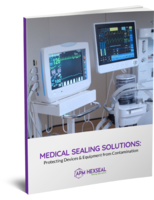Pressure Forming produces detailed plastic parts.
Share:
Press Release Summary:

Pressure forming utilizes vacuum pressure to 22.5 psi to draw heated plastic into cavities of mold and positive air pressure to 100 psi to push it into recesses of mold. Combination of negative vacuum pressure pulling and positive air pressure pushing results in parts, panels, and components with sharp detail, precise surface texture, and tight radii. Process employs pneumatically activated molds with movable sections for product removal.
Original Press Release:
Pressure Forming Produces Parts with Detail that Rival Injection Molding
Many Applications for Electronics
Howes Cave, NY-Very few plastic thermoformers can produce parts, panels or components with incredibly sharp detail, precise surface texture and tight radii. Until recently, such crisp and precise features were possible only via plastic injection molding. Pressure forming-a higher level process than conventional vacuum forming-has been refined by Kintz Plastics Incorporated.
o Vacuum Pressure Pulls Down: In conventional vacuum forming, vacuum pressure up to 22.5 psi draws heated plastic into the cavities of the mold.
o Positive Pressure Pushes Down: In pressure forming, a second dynamic is at work. In addition to vacuum lines that draw material into the cavities in the mold, positive air pressure of up to 100 psi against the back surface of the material pushes it into the recesses of the mold. The combination of negative vacuum pressure pulling and positive air pressure pushing heated plastic into every cavity of the mold enables deep undercuts, precise surface texturing, and sharp, crisp detail on the exterior of the pressure-formed part.
o Automated Mold Aids the Process: In addition, Kintz Plastics uses pneumatically activated molds that feature movable sections. Once a part with deep undercuts has been pressure formed, sections of the mold slide out so the part can be removed. Were it not for these movable panels in the mold, it would be extremely difficult-if not impossible-to remove a part with a deep undercut from its mold.
o Excellent Texture, Precise Engraving: Not only does pressure forming produce consistent wall thickness, sharp undercuts, deep draw and crisp details, it can also produce a consistent grained or textured surface across the entire face of the panel. Even logos and other insignia can be formed into the exterior of the pressure formed part. Using its in-house tooling capabilities, Kintz can even alter engravements on site as required by a revision change.
o Electronics Industry Applications: Manufacturers of electronic equipment are increasingly seeking housings, enclosures and panels that are durable and attractive, yet affordable. Pressure-formed plastic panels can be tooled much less expensively than injection-molded parts, and they can be designed and delivered faster. Also, as a product line evolves, revisions to the thermoformed part that requires mold modifications can be implemented faster and at far less cost than developing new molds for plastic-injection-molded panels.
In addition to vacuum forming and pressure forming, Kintz has considerable expertise in twin-sheet thermoforming. All three processes, as well as design and engineering support, tooling and fabrication, are performed on its nine-acre campus.
Since 1976, Kintz Plastics Incorporated has partnered with electronics industry manufacturers to produce parts, panels, housings, exteriors and components that add value to the OEM's products. Kintz has engineering coverage up to 12:00 midnight (EST) to insure that every customer receives optimal value and world-class service and support. With over 100,000 square feet of manufacturing capacity, and the largest thermoformer in the Eastern US-capable of producing thermoformed panels up to 9 by 13 feet with a 60-inch draw-Kintz is able to meet the heavy gauge vacuum forming, pressure forming and twin-sheet thermoforming needs of any OEM. For more information about Kintz Plastics, visit www.kintz.com or call (518) 296-8513.




